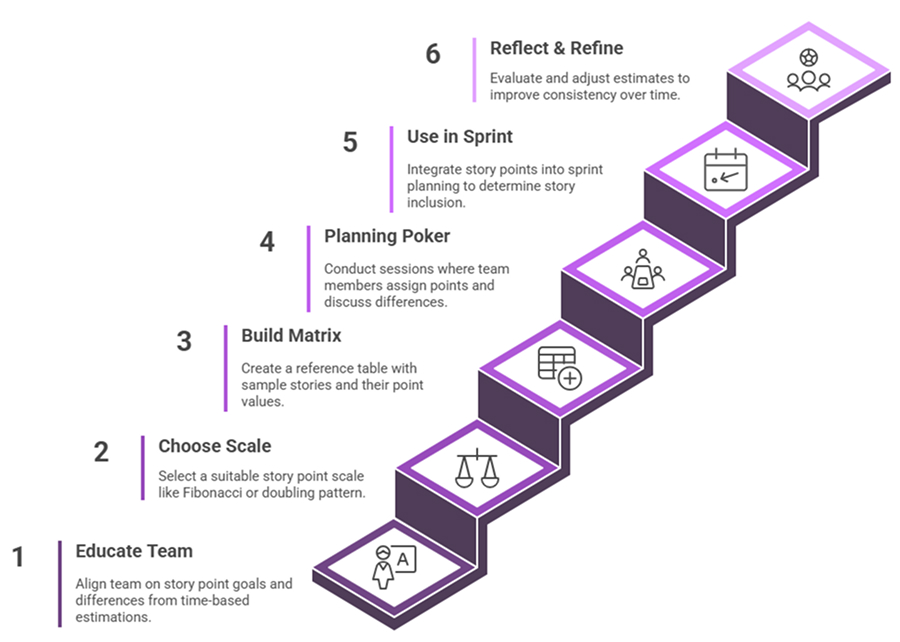Story points take into account factors such as complexity, risk, and effort, allowing teams to assess work based on how challenging it is rather than how long it might take.
Why Use Story Points in Agile?
Story points provide a flexible, team-centered approach to task estimation in Agile frameworks. Story point estimation focuses on complexity and effort rather than on hours. This allows teams to make more realistic and consistent assessments.
- Encourages collaboration: Team discussions are necessary to decide story points. This breaks down knowledge silos and establishes a shared understanding of the work.
- Enhances sprint planning: Teams can make informed and achievable sprint commitments by estimating effort in story points and referencing past velocities.
- Allows for velocity tracking: Tracking the number of story points completed each sprint gives teams historical performance data. This helps forecast future capacity and identify delivery trends.
- Supports continuous improvement: Regular estimation and retrospection help teams refine their understanding of complexity, improving estimation accuracy.
Best Practices for Effective Story Point Estimation
For Agile planning to be reliable, story point estimation must accurately reflect the relative effort and complexity. The following best practices help teams estimate more effectively:
- Split large stories: If the story is too large, it is difficult to estimate a time. So, before allocating story points, divide them up into smaller components.
- Estimate as a team: During estimation meetings, include every member of the Agile team.
- Pay attention to complexity: Don’t focus on the hours or days. Instead, estimate the effort. This change minimizes deadline pressure.
- Record assumptions: Write down each factor that affected the estimate. Later on, this will be useful if identical tasks arise or if assumptions alter.
- Avoid comparing teams: Every team has its own estimates for velocity and story points. Story points should not be compared or benchmarked between teams.
Creating and Using Story Points
 Successfully adopting story points requires a clear, consistent approach. The six steps below help Agile teams implement story point estimation effectively:
Successfully adopting story points requires a clear, consistent approach. The six steps below help Agile teams implement story point estimation effectively:
1. Educate the team on story points.
- Start by educating your team on story points. Discuss how they differ from time-based estimations and their importance in Agile.
- Make sure the team shares a common understanding of why story points are used before estimating.
2. Choose an estimation scale
- Choose a story point scale that works for your team.
- The Fibonacci sequence (1, 2, 3, 5, 8, 13…) or a straightforward doubling pattern (1, 2, 4, 8…) are popular choices.
3. Build a reference matrix
- Make a reference table or matrix that lists sample stories and the point values that go with them.
- This provides the team with a common baseline for evaluating upcoming tasks and aids in standardizing estimation.
4. Conduct a planning poker session
- Team members individually assign story points to a task and then discuss any major differences before reaching a consensus.
5. Use story points in sprint planning
- Use the estimations to determine how many stories to include in the sprint once they are ready.
6. Reflect and refine your estimates
- After a few sprints, evaluate the accuracy of your story point estimates.
- Use retrospectives to adjust your reference stories and improve estimation consistency.
Challenges in Using Story Points
While story point estimation is widely adopted in Agile, it has a unique set of difficulties.
- Different team members may interpret a given number of story points in different ways.
- Teams that are new or inexperienced may underestimate the amount of work required to complete assignments.
- Story points are frequently used by stakeholders to evaluate individual productivity or link them to delivery schedules.
- Different teams may estimate similar tasks with very different point values, leading to confusion in multi-team environments.
Story Points vs. Time-Based Estimation
Time-based estimation is the process of guessing how long something will take to finish, usually in hours or days. Story point estimation focuses on estimating a task’s relative effort, complexity, and risk regardless of how long it might take in actual time.
1. Pressure and Performance
- Time-based estimating frequently leads to individual performance tracking, which can increase pressure.
- Story points are intended to measure team velocity and assist long-term delivery.
2. Estimation Process
- Estimating by time is typically done by one person at a time.
- Estimating by story points encourages team consensus and debate, resulting in a more accurate and common picture of the job.
3. Flexibility
- Time-based estimates are rigid and difficult to amend as requirements change.
- Story points are more adaptable and easily modified during backlog grooming or sprint planning.
Conclusion
Story points give Agile teams a strong and adaptable method of estimating work based on complexity, effort, and risk. If properly adopted, teams can reduce estimation stress, improve communication, and increase sprint planning accuracy over time. Using story points is not just a choice for teams aiming for sustainable delivery; it is a clever approach to Agile development success.
